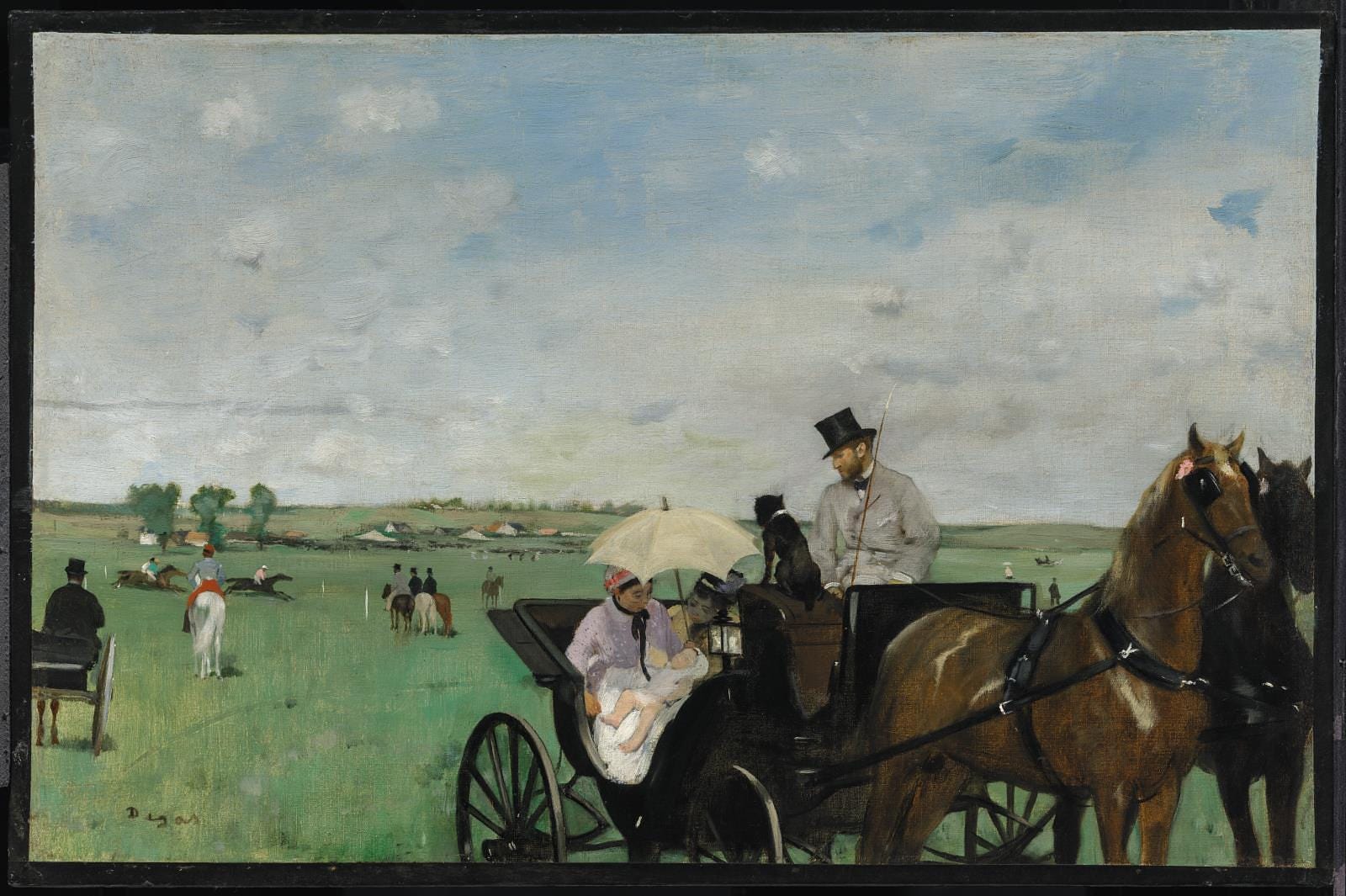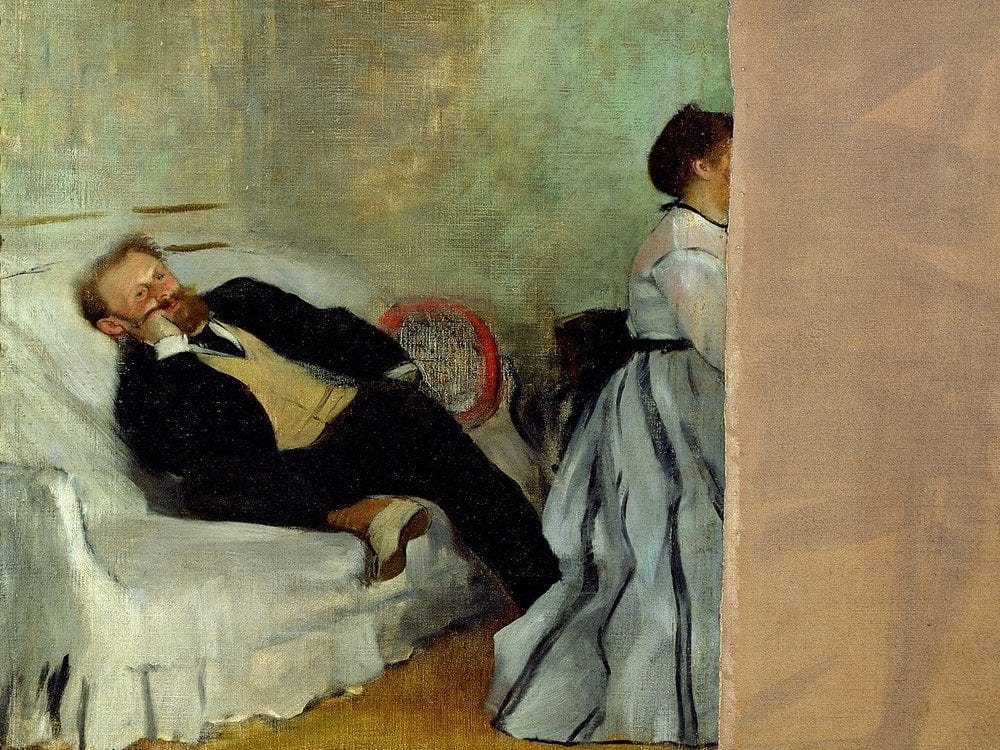Chance Encounters, Edition 5
On the Verge of Impressionism: Manet and Degas

After reading about the current exhibition Manet/Degas at the Musée d’Orsay in Paris, I found myself thinking about these two artists and the many aspects of their lives and art that tie them together, and also about things that separate them.
Édouard Manet (French, 1832-1883) was one of the founders of the Realist artistic movement, a radical effort to drag French painting out of its obsession with Classical and Renaissance styles and subjects. He did so by choosing works by Renaissance masters and updating the styles and subjects to represent unidealized figures with simplified shading and extremely painterly form.

Le Déjeuner sur l’herbe (Luncheon on the Grass) was submitted by Manet to the French Academy of Fine Arts Salon jury in 1863. The Salon was the official exhibition of the French Academy, held annually or biennially, from 1667 on. This exhibition was the gateway to artistic success including government commissions, Academy appointments, travel prizes, and the attention of journalists and patrons. In 1737, the Salons were made fully open to the public and from 1748 on, a jury of previously exhibited artists determined acceptance of works for the Salon. Visiting the Salon and seeing the latest art became a popular activity among the Parisian elite.
The jury of 1863 was unusually severe and many artists whose works had been accepted previously, including Édouard Manet, were rejected. Outraged artists sought relief from the Emperor Napoleon III. His solution was to institute the Salon de Refusés (Exhibition of Refused Works), into which any work that had been rejected by the jury could be entered. Manet’s Déjeuner was one of the centers of attention at this exhibition, and the source of much shock and ridicule. The combination of a nude woman with two fully clothed men is still startling. But in 1863, the extreme painterly form was considered evidence that Manet was lazy and ill-trained.
Two years after this scandal, Manet’s Olympia provoked similar outrage and dismay. The jury in 1865 accepted Manet’s painting, but his work was no more acceptable to critics and viewers. The reclining female nude was a well-established and widely accepted theme in European art by the mid-nineteenth century, but Manet’s painting translated the traditionally idealized and sensual Classical goddess into a woman of nineteenth century Paris. The woman in Olympia was easily recognized as the same nude featured in Déjeuner, artist and model Victorine Meurant. Instead of a seductive gaze, she looks at the viewer as if challenging them to explain themselves. The shoes worn in bed, the hissing cat, and the rumpled bed were all interpreted as indicating that this woman is a prostitute. Again, Manet’s painting drew widespread condemnation from Establishment critics but younger artists were fascinated by the possibilities they recognized in Manet’s bold and painterly works.

Edgar Degas (French, 1834-1917) was one of that group of artists which took Manet’s style and built on it to develop the style that is known today as Impressionism. This group of artists, including Claude Monet, Pierre-Auguste Renoir and Camille Pissarro and others formed the Société Anonyme Coopérative des Artistes, Peintres, Sculpteurs, Graveurs (Cooperative and Anonymous Society of Artists, Painters, Sculptors and Printmakers). This group created the first independent group exhibition of art. Having witnessed the brouhaha that had surrounded the Realists’ challenge to the French Academy of Fine Arts and recognizing that their own works were unlikely to be approved by the Academy and its Salon judges, agreed to exhibit their works jointly. Though Degas had earlier succeeded in having works accepted into the Salon, he joined the Society in ignoring the Salon from the time of the first of their exhibitions in 1874. At the Races in the Countryside (above) was one of the 10 paintings Degas exhibited in that first Impressionist exhibition.
The term Impressionist was coined in a hostile review of that first exhibition but throughout his career, Degas rejected that name for his work, one of many points of contention between Degas and his colleagues. Indeed, Impressionism doesn’t seem to describe Degas’ work for much of his career or to fit the artist’s own ideas of what art should be about. Though many of his colleagues focused on landscape painted en plein aire (outdoors), Degas abhorred the practice and saw himself continuing the long tradition of figure painting, while incorporating Impressionist concepts of transitory light effects, painterly form, and themes of contemporary life.

This is apparent in Degas’ painting of his aunt, her husband, and two children, Family Portrait or The Bellelli Family. The carefully delineated figures and furnishings stand out from the more painterly wall, mirror and rug. This same contrast appears in At the Races in the Countryside, though it is less noticeable there because of the expansive landscape.
Édouard Manet befriended many members of the Société Anonyme, including Edgar Degas. The two artists had much in common. They were close in age and each had disappointed his father by choosing a career in art over one in law. Both had studied art in Italy, and by copying in the Louvre. Both families were well-off, Manet’s being particularly wealthy and well-connected. Both artists had fought in the Franco-Prussian War in the early 1870s. Manet and Degas shared a desire to succeed as figure-painters and both worked toward success through the official Salon. While Degas abandoned the Salon, Manet continued to submit his works, though with little success. Their choices of subject often coincided as well, activities of Parisian leisure like horse racing, street scenes, restaurants and cafes, concerts and the theater.


The two paintings above were painted very near one another in time. Manet’s Plum Brandy, with its bright colors, shows how much his work had been influenced by the Impressionists’ ideas between 1863 and 1877. Though similar in theme, Degas’ In a Café has a more pessimistic and depressed mood. Though it had been exhibited in the Second Impressionist exhibition, its muted color and filtered light make clear how closely Degas adhered to the Realism style.


In this pairing, we see both artists depicting horse racing at Longchamp, a racecourse near (now in) Paris. Going to the horse races had become an extremely fashionable pastime in the second half of the 19th century and these two fashionable artists joined the crowds at the track. Manet’s paintings of the events at the track are rarer and more sketch-like than Degas’ works on the same subject. The specific themes chosen by the artists are also different. Manet chose an unusual point of view, just beyond the finish line as the horses thunder toward us. For Degas, it is the bodies of the horses and jockeys after the race that are of greatest interest.
Though they had much in common, their personalities and personal lives were quite different. Manet was reportedly a friendly, social person, who married Suzanne Leenhoff in that momentous year of 1863. Degas believed a serious artist should have no familial entanglements and deliberately encouraged a curmudgeonly reputation.

In the 1860s Degas painted a portrait of Manet listening to his wife play the piano, giving it to his friend as a gift. For reasons we will never know, Manet was so offended by the portrayal of his wife Suzanne that he cut it away and destroyed it. Upon discovering the damaged painting, Degas repossessed it. One of many spats the artists had, but Degas’ enduring respect for Manet continued past Manet’s death in 1883 to Degas’ own death in 1917. After Degas’ death, the work was discovered in Degas’ extensive art collection, alongside 80 works by Manet.
Manet/Degas continues at the Musée d’Orsay until June 23, 2023 and will be shown at the Metropolitan Museum of Art in New York City from September 24, 2023 until January 7, 2024.



We just got a Summer Rerun😜
Really enjoyed the commentary.